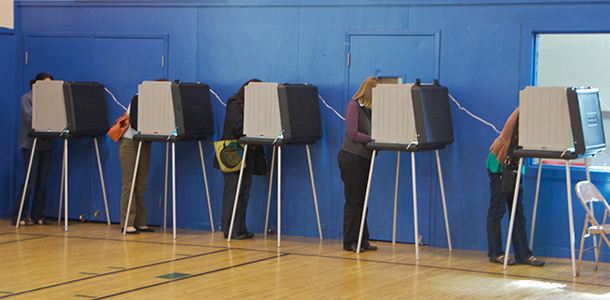
Polling place in San Francisco (Photo Credit: Steve Rhodes/Flickr)
By definition, conventional wisdom is convention. It often has the added value of being right.
I read a commentary by Joe Matthews recently that argued California’s Top Two Primary works against centrists and actually increases the advantage of the more ideological candidates of the left and right.
He argued that the pending primary battle between U.S. Senator Dianne Feinstein and her progressive Democratic challenger Kevin De Leon would force the five-time Senator to run to the left.
Matthews mentioned that the conventional wisdom of the Top Two is that “it favors the incumbent Feinstein because, as the more politically moderate candidate, she can put together moderate Democratic voters, centrist independents, and Republicans into a broader, winning coalition.”
Yes. Pretty much that’s exactly what Top Two is designed to do: to elect candidates who are attractive to the largest number of people.
An open primary is any primary election in which a voter either does not have to formally affiliate with a political party in order to vote in that primary. The top two finishers from the primary election then advance to the general election.
In their book, Nonpartisan Primary Election Reform: Mitigating Mischief, authors R. Michael Alvarez and J. Andrew Sinclair studied California's use of Top Two and found that many voters—especially minority and young voters—appear to be empowered by the election model.
Californians who describe themselves as independents now are about 25 percent of the electorate, essentially as many as call themselves Republicans. Among millennial voters, the percentage is even higher. They aren’t especially excited about either party.
The Top Two is aimed at honoring the axiom that people are allowed to vote for the person and not the party.
When you look at the California Legislature, you can see the impact of the open primaries in creating the change that those of us who supported the Top Two thought would occur. A group of centrist, business-aligned Democrats—called the Mod Dems—has been a pivotal bloc of votes on bills on taxes and environmental regulation that frustrates some of their more liberal Democratic colleagues.
The political dysfunction that gripped Sacramento for years has eased—and things are getting done. Others around the country have noticed. At California Forward, we have been contacted by people in other states wondering how to bring that type of change to their constituents.
Earlier this year, CA Fwd convened the 50 State Solution to baseline state-based efforts and convene citizen leaders who explored ways to encourage communication among reform groups for the purpose of catalyzing and accelerating change across the country.
California's open primary, Citizens Redistricting Commission and recent term limit reforms—all voter approved—have fueled the improved functioning of our state and local governments. While there's more work to do, we’re not “ungovernable” anymore as one national magazine famously headlined over a decade ago. Rather we are a model for what reform can do.
When Matthews says the Top Two means Feinstein and DeLeon may run against each other twice, he may be right. If they finish as the top two vote getters in next June’s primary, they’ll run again in November. However, when Joe Matthews says that the Top Two Primary works against centrists—he’s just wrong.
Lenny Mendonca is co-chair of California Forward's Leadership Council.

